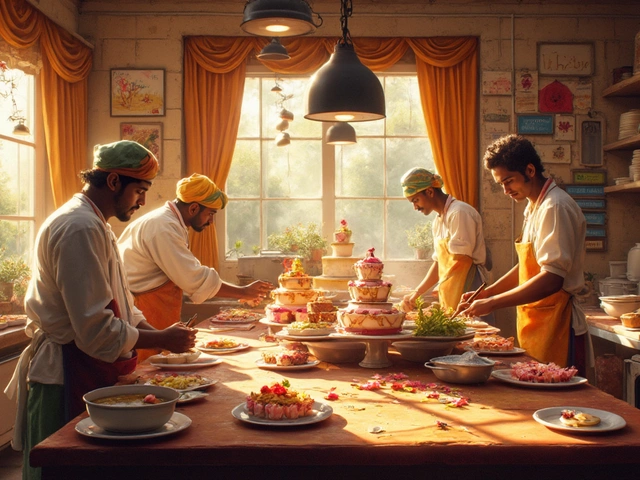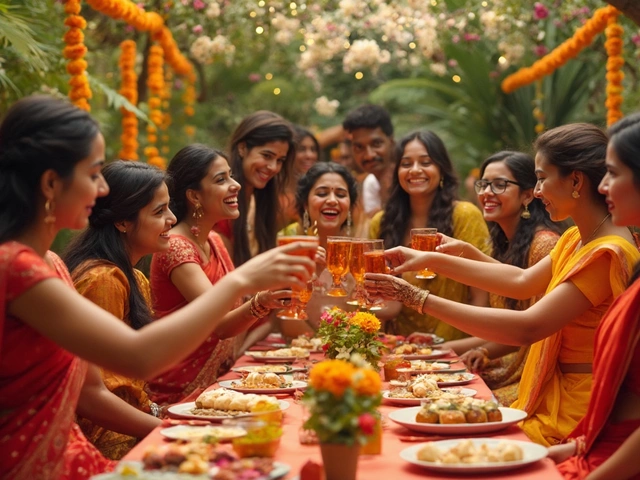
Picture this: You step into a wedding venue, and it feels like you’ve entered a secret garden. Twinkling fairy lights hang from the rafters. Lush floral garlands drape across the tables. Every detail, from the bold centerpiece to the delicate place cards, fits the couple’s vibe perfectly. Decorations are more than just pretty stuff—they set the entire mood of a wedding day. But have you ever wondered who’s footing the bill for all that magic?
Wedding Decor Traditions: Old Rules vs Modern Realities
Once upon a time, wedding expenses were almost set in stone. The bride’s family picked up most of the tab, especially for church or ceremony decorations, reception flowers, and even the romantic archway. The groom’s family usually handled the rehearsal dinner, sometimes boutonnieres and small accents, but not much else on the decor front. That script has started to unravel over the years. Today, budgets are a team sport. Couples, both families, or even friends can join forces to create the wedding environment everyone dreams about.
The world isn’t the same as it was a generation ago. Couples get married later, often after living together for years or building up savings. Money sometimes comes from more than one household—sometimes three or even four if there’s step-family involved. There’s no universal rule anymore; tradition can still matter, but practicality gets the top spot now. According to The Knot’s most recent Real Weddings Study, nearly 51% of couples paid for their wedding decor themselves in 2024. Only about 33% relied mainly on either the bride’s or the groom’s parents, with the rest split among shared contributions and even crowdfunding platforms.
You’ll also see cultural differences. For example, in some communities, the groom’s family takes care of all floral arrangements. In others, the bride’s side handles even the table runners and lighting. But culturally specific roles aren’t as rigid anymore. With so many different family structures and backgrounds blending together, it’s rare to see an “only one team pays” mentality. Instead, people talk openly—sometimes awkwardly—about what everyone’s comfortable spending money on.
Many couples put a high value on keeping things fair. Maybe each family chips in a set amount, and then the couple decides how to split it. Or two families collaborate on a flower budget while the couple funds a cool seating chart display or those TikTok-worthy neon signs. You might even see friends sponsor a photo booth or special centerpiece as their wedding gift. Flexibility is the secret sauce in today’s wedding world. So, ditch what you’ve heard about “rules”—start by having an honest conversation (even if it feels a little tough at first!) about who wants to contribute, and how much, to those big decor moments.
Typical Costs of Wedding Decor: What’s Included and What to Expect
Let’s get real for a minute—decor costs can sneak up on you faster than you’d expect. The average couple spends about $2,400 on wedding decorations in the US, but this number seesaws wildly depending on how you define “decor.” Are we talking fresh peonies on every surface, or are we counting DIY mason jar centerpieces and string lights from Amazon? Here’s where most of the budget usually goes:
- Centerpieces and table decor (flowers, candles, runners)
- Ceremony arch or chuppah
- Floral arrangements for entrances, aisles, and altars
- Linens, napkins, and charger plates
- Lighting setups (uplighting, fairy lights, lanterns)
- Signage (welcome boards, seating charts)
- Backdrops for photos
- Chair covers and sashes
- Decor for dessert tables, gift tables, bars
According to WeddingWire’s 2024 trends report, here’s how the spending usually shakes out for mid-range weddings in the US:
| Item | Average Cost |
|---|---|
| Centerpieces & Table Decor | $500 - $1,200 |
| Lighting | $300 - $700 |
| Ceremony Backdrop/Arch | $200 - $800 |
| Floral Arrangements (Bouquets, Aisle, Altar) | $500 - $2,000 |
| Signage & Stationery | $150 - $400 |
| Other Decor | $250 - $900 |
These categories can overlap, so “decor” doesn’t have a hard-and-fast price. You can throw a super cozy micro-wedding with origami flowers and thrift shop finds for a few hundred bucks or go all out with hanging floral installations and get hit with a $20,000 bill. The real key is figuring out your style and setting limits before the spending gets out of hand. Here’s a favorite tip: Build a decor board (on Pinterest or even with magazine clippings) so everyone involved—parents, in-laws, creative friends—can see what matters most to you. Prioritizing makes cutting costs and dividing payments much easier, and it helps prevent fights over “necessary” versus “nice-to-have” details.
Florists and decorators usually require deposits up front—sometimes 20–50%—with the rest due right before the big day. Couples who DIY should count their supplies, labor, and yes, even all those tiny glue sticks (trust me, they add up!). Rentals, like candle holders or fancy linen napkins, are often paid a week in advance. If you’re hiring a full-service designer, expect to pay for both their time and for the materials. Bottom line: Know what’s non-negotiable (maybe it’s fresh flowers or perfect lighting?). Then work from there.

How Couples and Families Split the Bill in 2025
If you ask your parents or grandparents who paid for their wedding decor, the answer might be as simple as, “Oh, my parents did everything.” Fast-forward to today, and it’s a mix of new customs and old-school etiquette. And let’s be honest, transparent convos about money might not feel sexy, but they can save you from major headaches later.
Couples today are in the driver’s seat. According to Zola’s 2025 survey, 57% of couples say they cover most or all of their wedding decor budget from personal savings. That number’s grown steadily for the last five years. Parents might step in for big-ticket items (think full floral installations or a showstopper arch). Sometimes, families will offer to pick up specific pieces that are important to them—maybe the bride’s mom covers the chuppah, while the groom’s parents want to splurge on neon signs or funky lounge rentals.
If you want to split things up fairly, here are a few approaches couples use now:
- Divide by importance: Each person or group funds the pieces they care about most—a mix of family pride and personal taste.
- Percentage breakdown: Parents each contribute a set percentage (say, 30% each), and the couple does the rest.
- Specific assignments: Mom covers all floral needs, in-laws handle lighting, couple tackles signage and DIY projects.
- Gift approach: Friends fund a decor detail as a group wedding present (those custom escort cards add a personal touch and a happy memory).
Some couples get creative and crowdsource bit by bit, especially for offbeat items or quirky extras. An Amazon wish list of decor items makes it super easy for relatives and friends to chip in for vases, lights, or even silk flowers. More and more couples are using cash registry sites, where anyone can sponsor a piece of the décor. There’s no embarrassment in asking for help, but be specific so people know what their money is going toward.
Don’t overlook how communication can keep things smooth. One bride told The Spruce in 2025, “We asked each family to fund their tradition—whether it was flowers, candles, or signage. It made everyone happy, and nobody felt left out.” That hint of clarity keeps tension to a minimum but lets everyone celebrate their favorite details.
One more twist: sometimes, whoever is most handy or creative will offer “sweat equity” by handling DIY projects, which cuts cash costs and shares the emotional investment. Aunt Linda loves crafting? She might whip up personalized table numbers and save you a little cash. That kind of gift is priceless—and honestly, it makes everyone more invested in the celebration. Just be sure not to ask too much of one person—it’s a party, not a homework assignment!
Smart Tips and Fresh Ideas for Decorating on Any Budget
So you know who might pay, but how do you keep costs down—or make the most of a bigger budget? Start by being honest about what you can and can’t afford. Here are some real-world ideas from couples who pulled off weddings that wowed guests and their wallets:
- Embrace multi-use items—ceremony flowers can double as reception centerpieces.
- Go seasonal and local: local wildflowers or greenery can cost 40% less than out-of-season blooms flown in from afar.
- Don’t discount non-floral decor. Think: candles, lanterns, and even fruit or veggie centerpieces (no, seriously—lemons in glass vases pop in summer).
- Rent, don’t buy, where you can—everything from arches to fairy lights is available from party rental shops.
- Shop secondhand. Many couples sell lightly used wedding decor on Facebook Marketplace or local apps right after their weddings.
- DIY wisely—make sure you (and your crew) have time and energy to follow through. If you’ve never arranged flowers before, now isn’t the moment to experiment on a large scale.
- Batch buying: Some florists give a discount for ordering bouquets, boutonnieres, and table arrangements together.
- Lean on digital—project a gorgeous image on a screen instead of renting a massive (and pricey) custom backdrop.
You can also ask vendors if they have off-peak rates. A Saturday wedding in June will always cost more than a Thursday or Sunday bash in October. You might save up to 20% on decor if you’re willing to celebrate in the off-season. Another pro move: limit your color palette to simplify what you buy—and create a more cohesive look in photos.
Be sure to budget for set-up and breakdown fees, too. Lots of couples forget about those and end up with last-minute costs. If friends or family step up to help decorate, thank them in a way that feels sincere—maybe a special shoutout at the reception or a mini gift. That little acknowledgment goes a long way.
There’s no “normal” anymore; just what works best for you. If you’re open with each other and your families, you might even find people are happy to contribute—or at least point you toward good deals. At the end of the day, the only real rule is that the day should feel true to you and your partner—even if that means a few mismatched vases and wild garden flowers plucked on the morning of the wedding.
"Every couple should think about what’s meaningful to them, not just what Instagram tells them is necessary. Talk about budgets early, include the people who want to help, and remember—the memories, not the price tags, last a lifetime." — Meg Keene, Editor-in-Chief, A Practical Wedding
Remember, weddings should feel like a celebration, not a tug-of-war over who pays for the napkins. The magic is never in the dollar amount—it’s in the joy, the laughter, and yeah, maybe a little leftover confetti in your shoes.



Comments
Post Comment